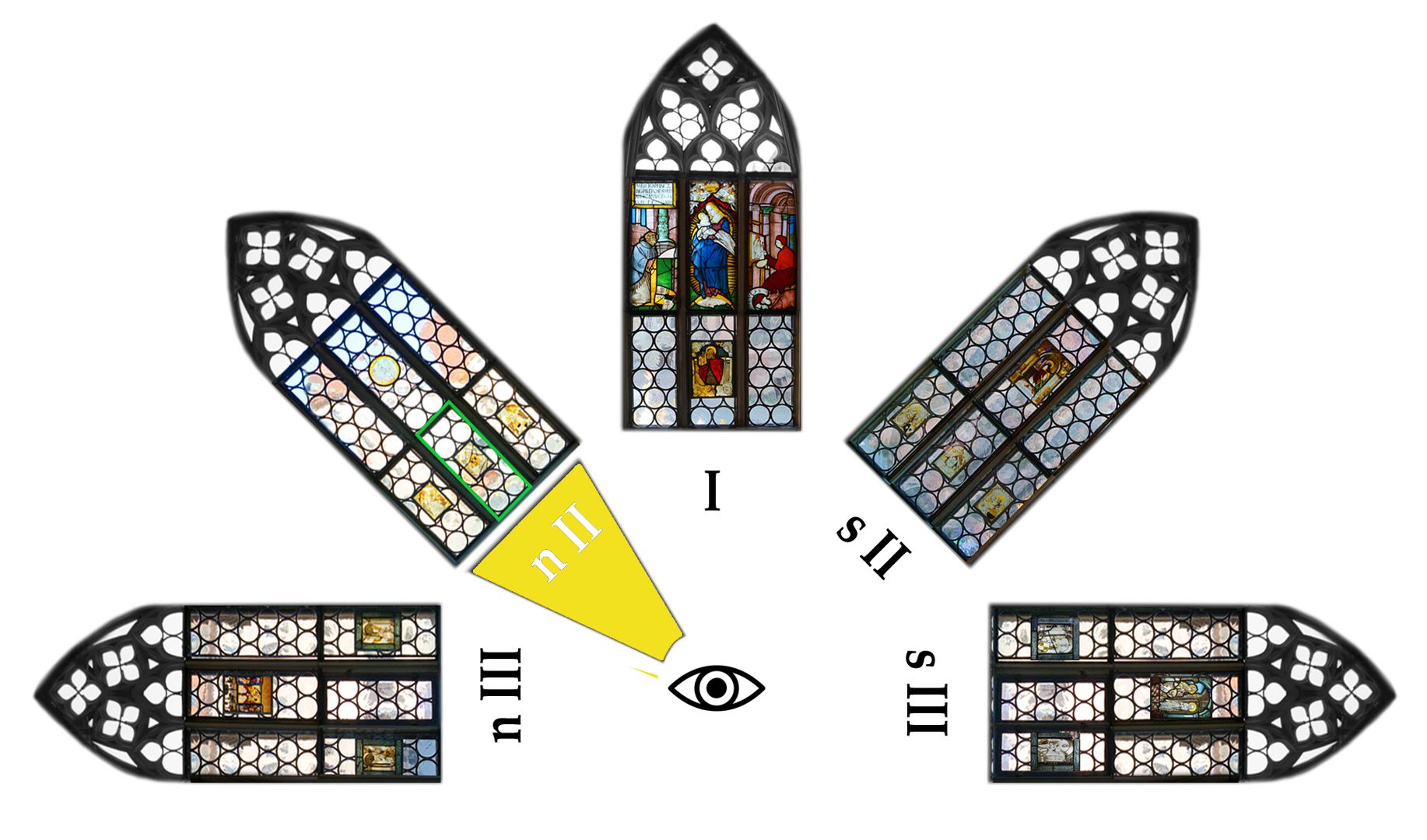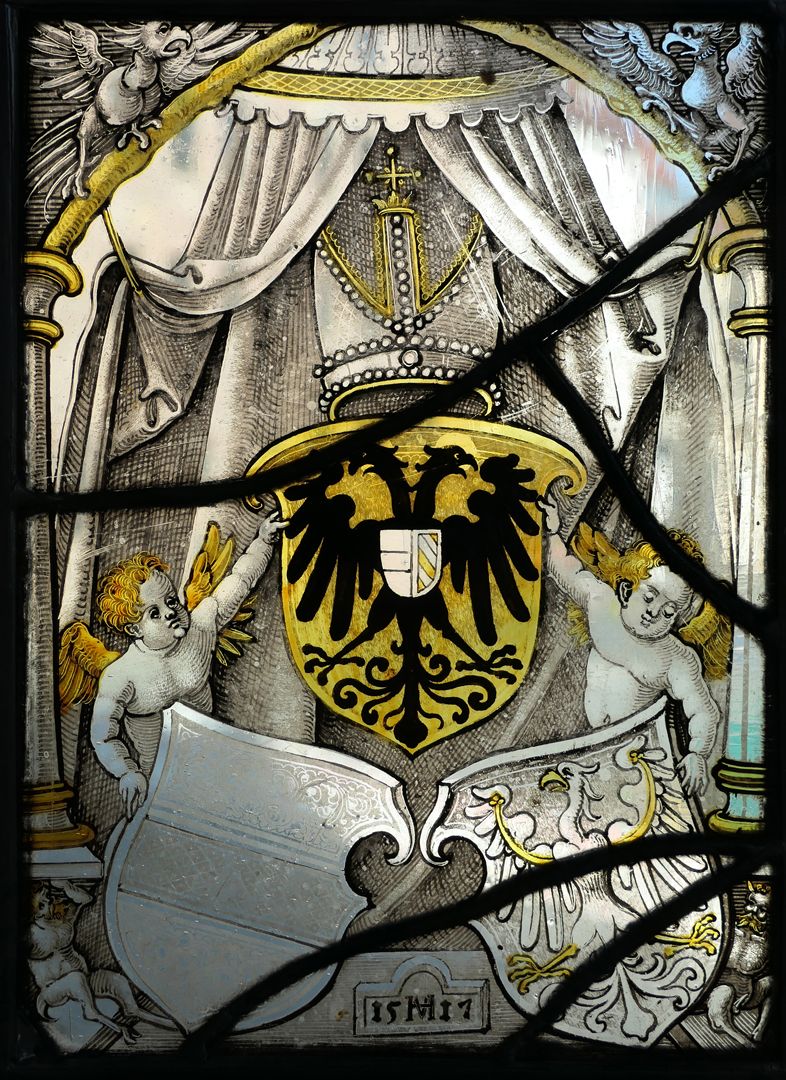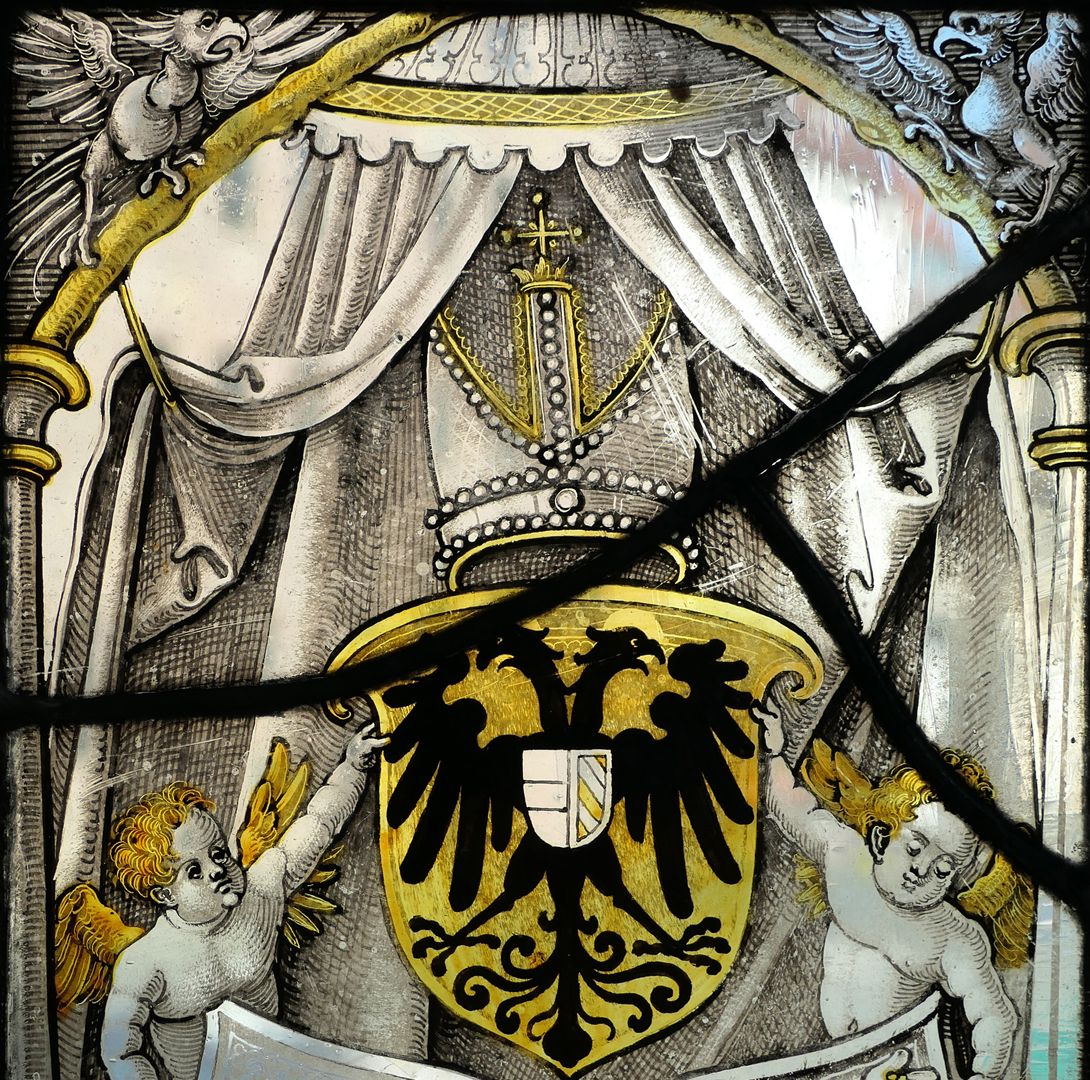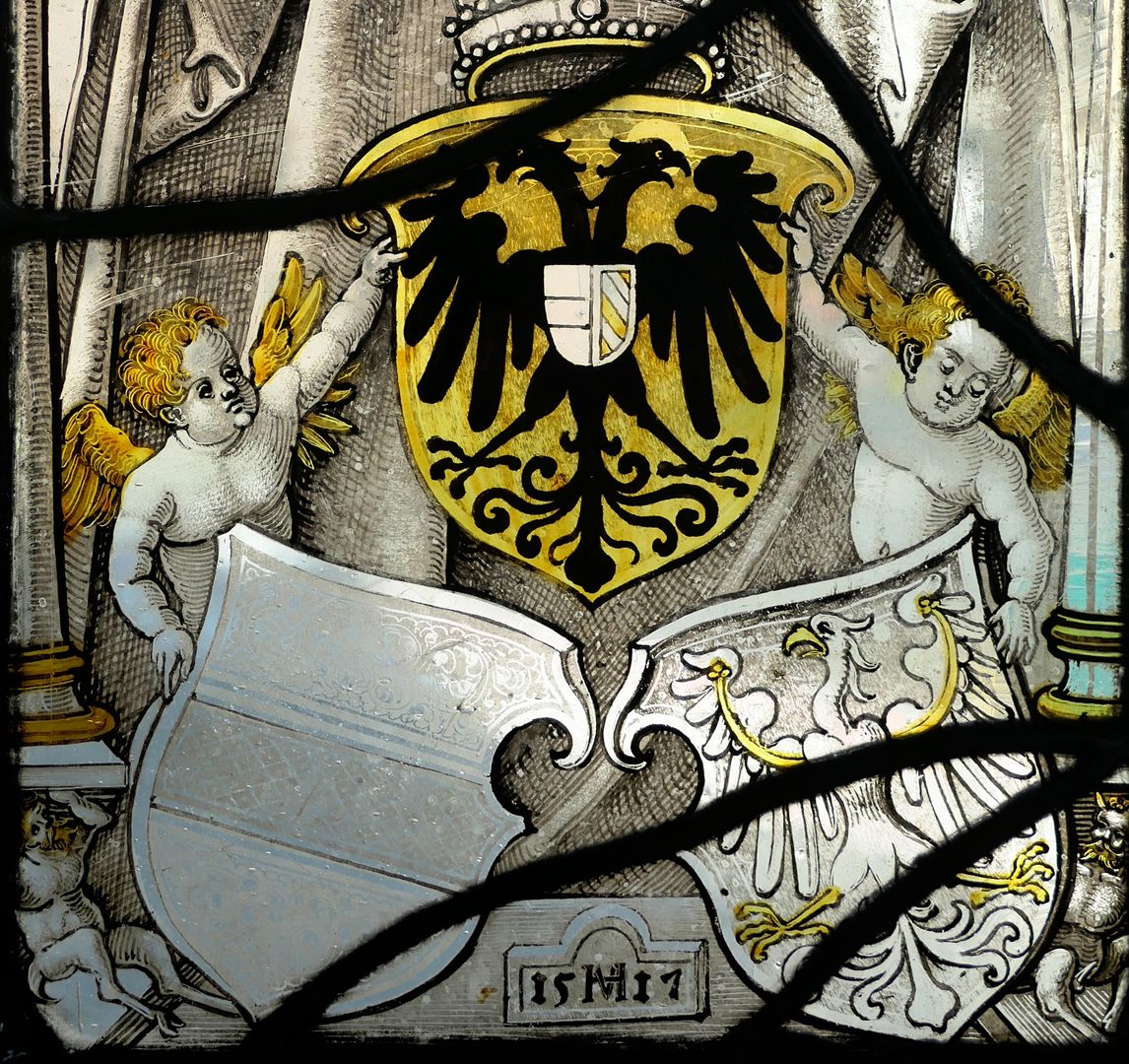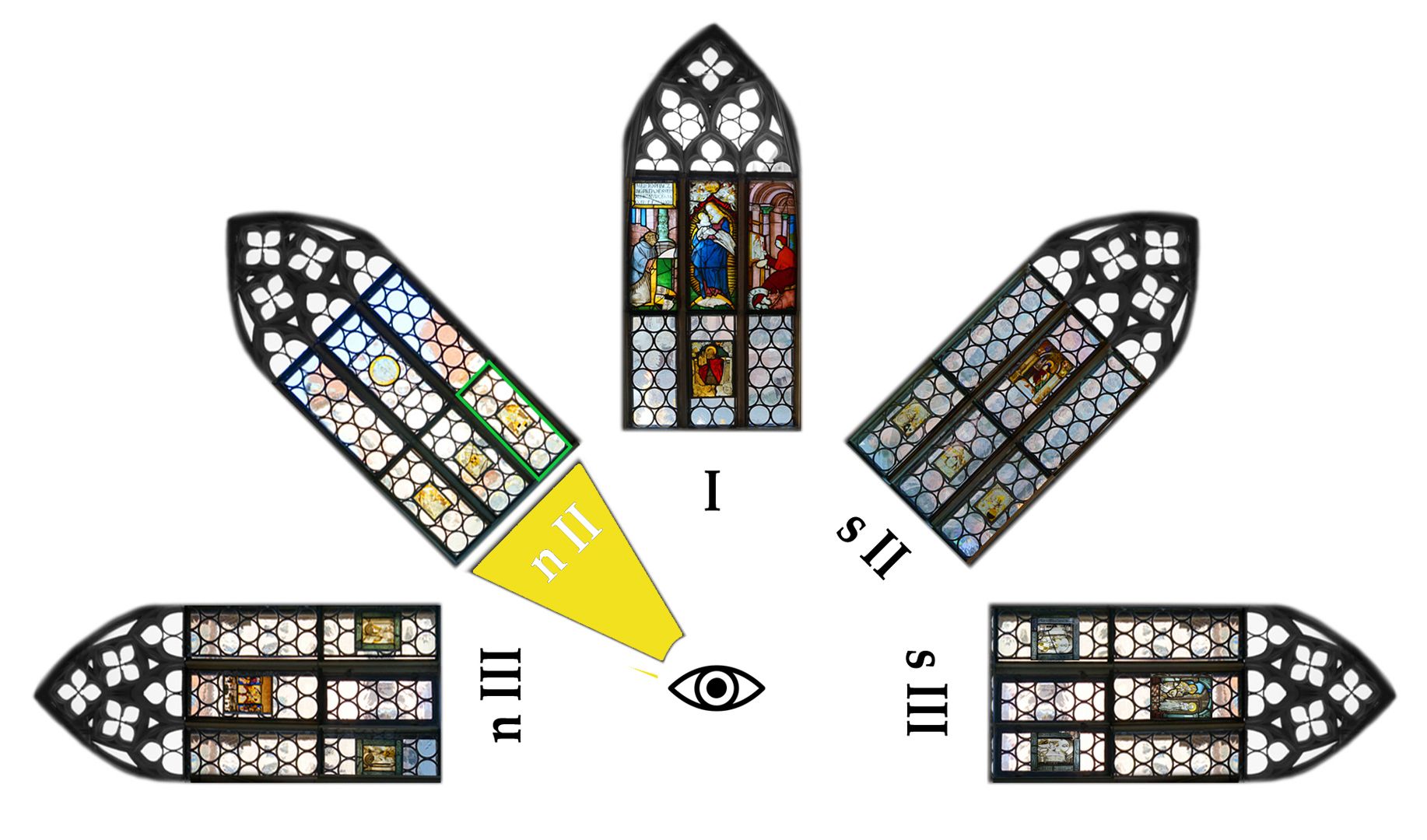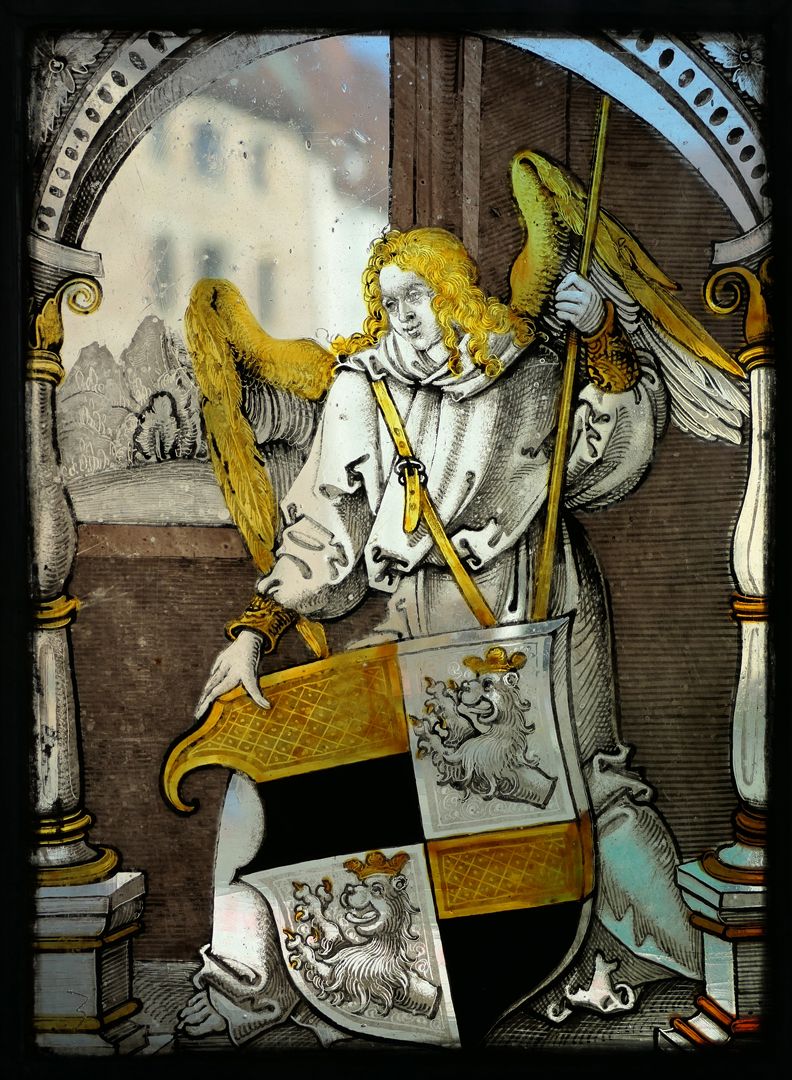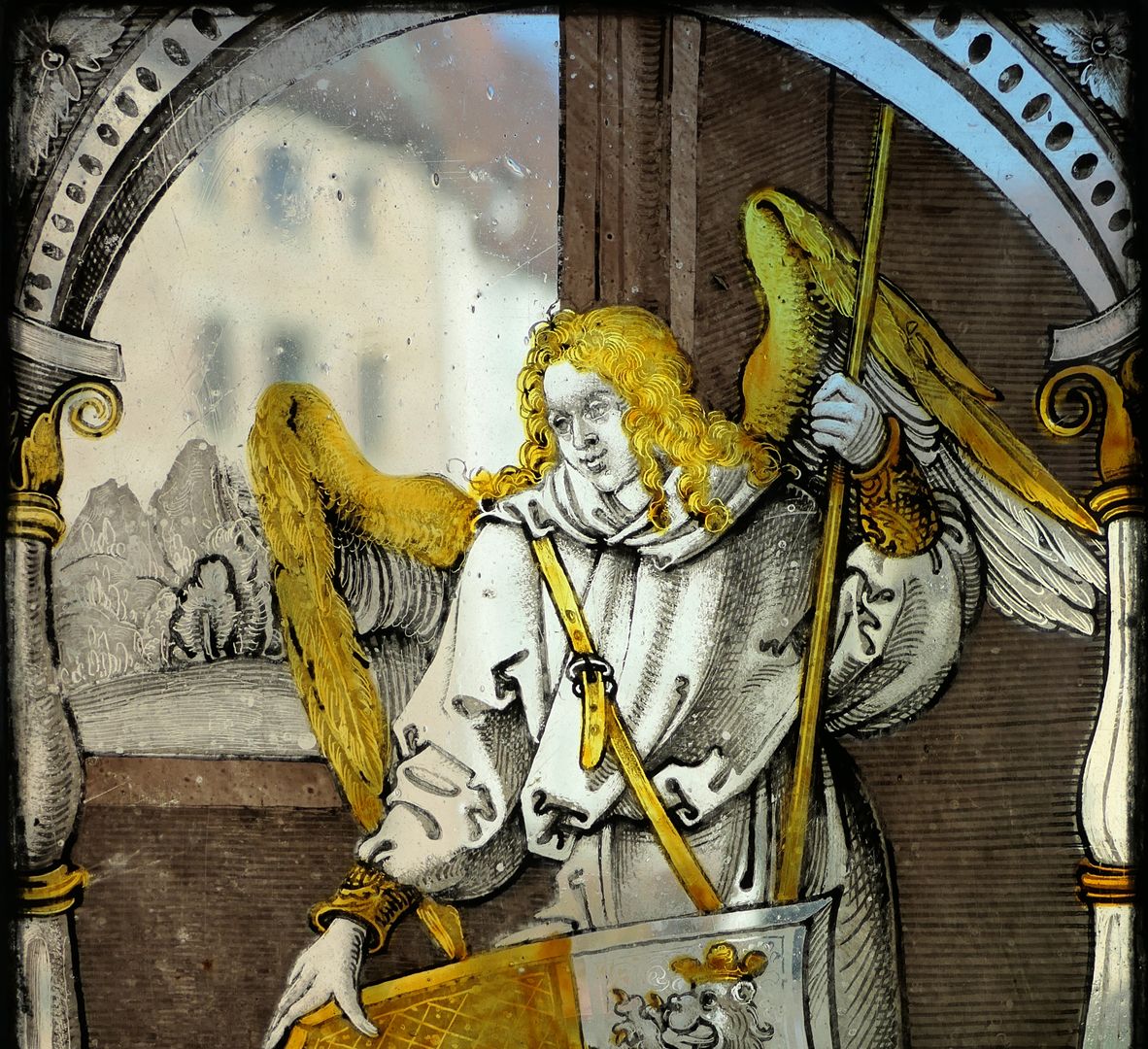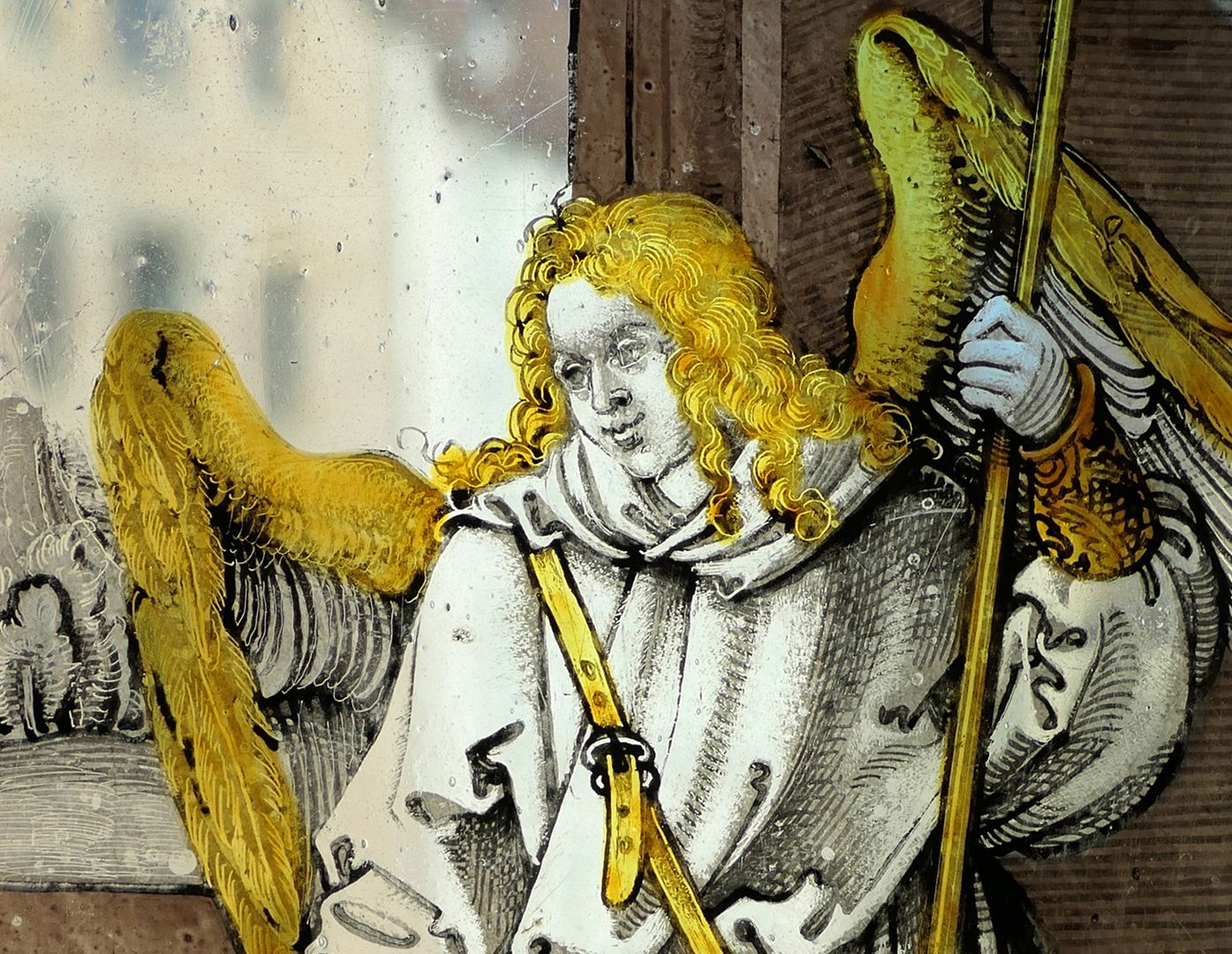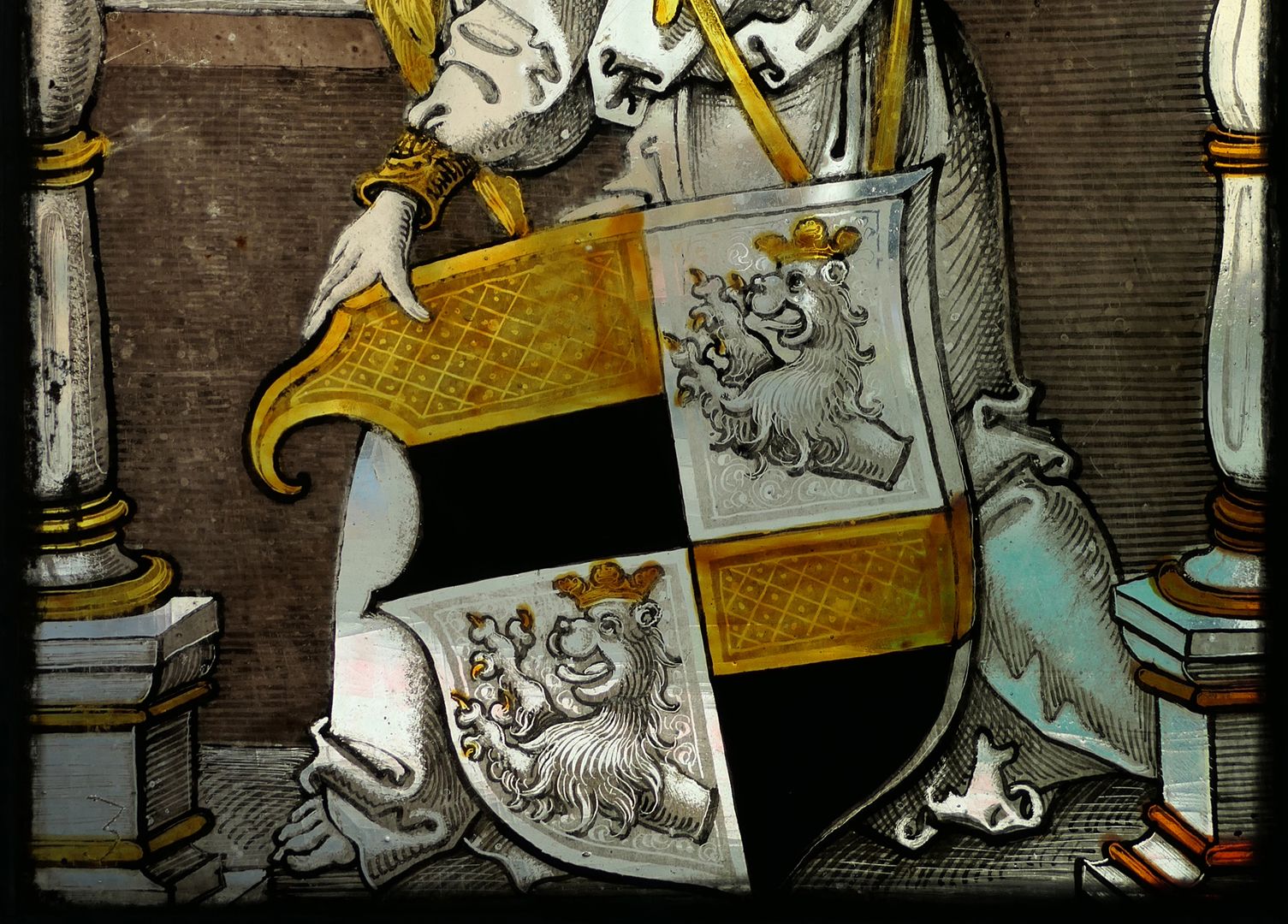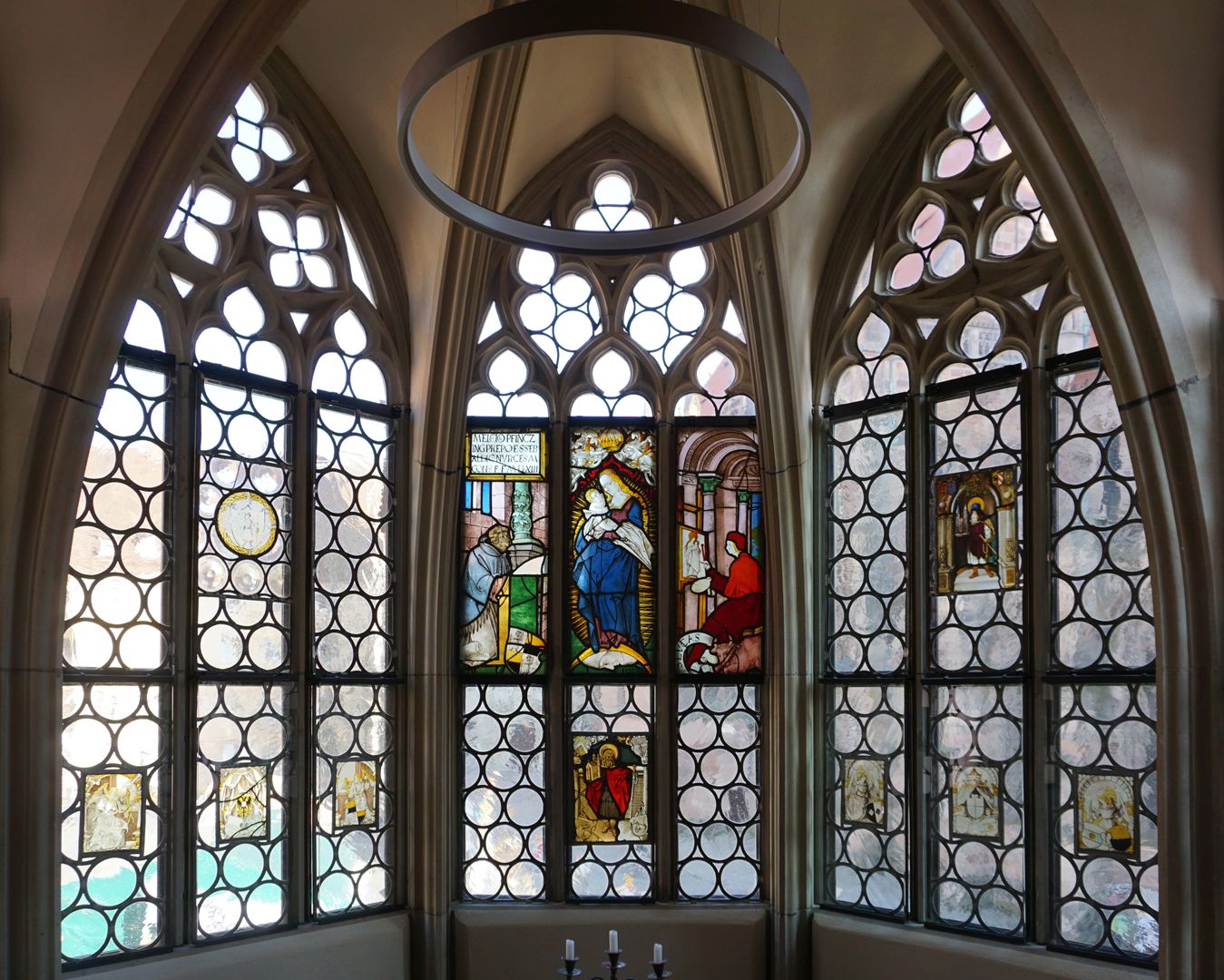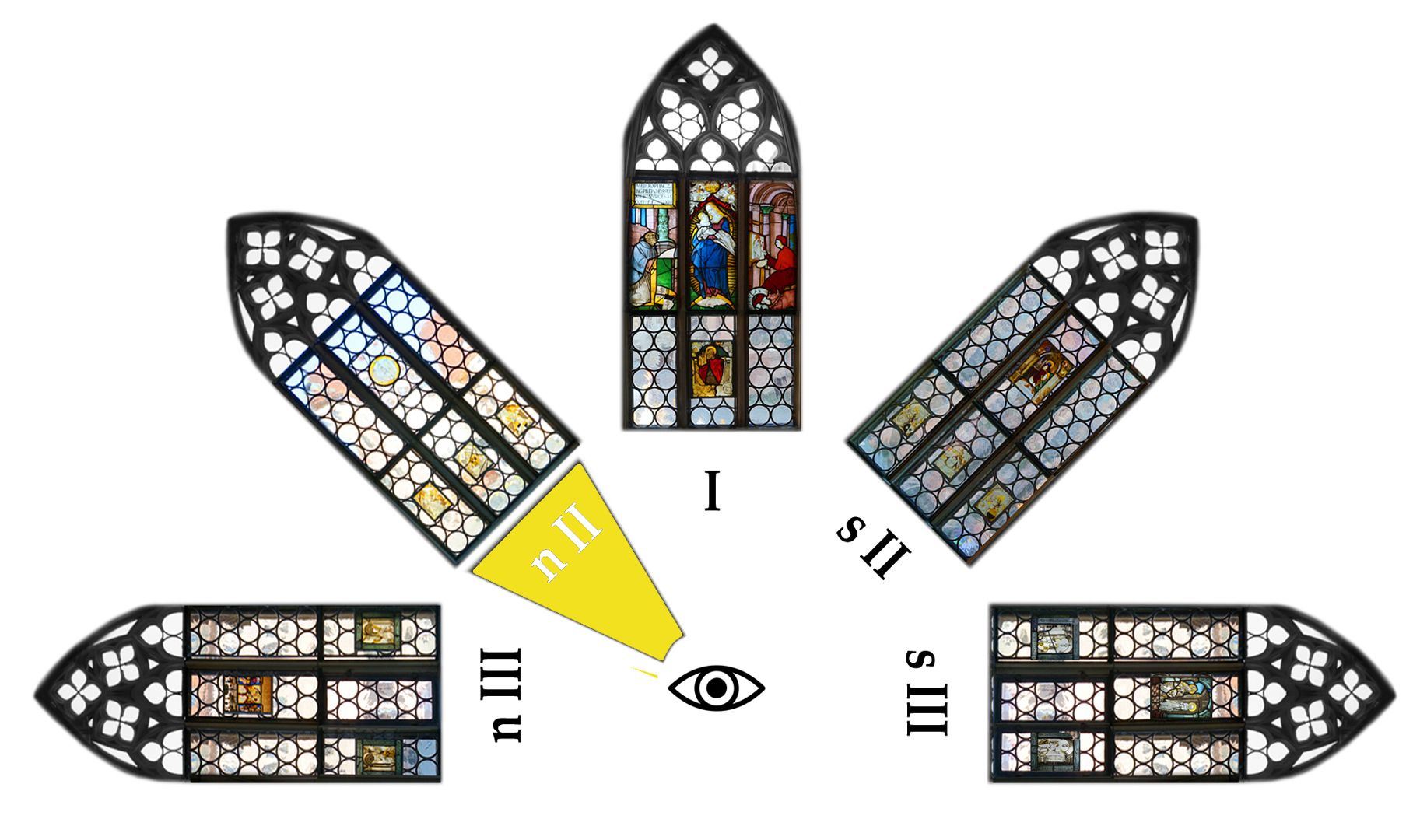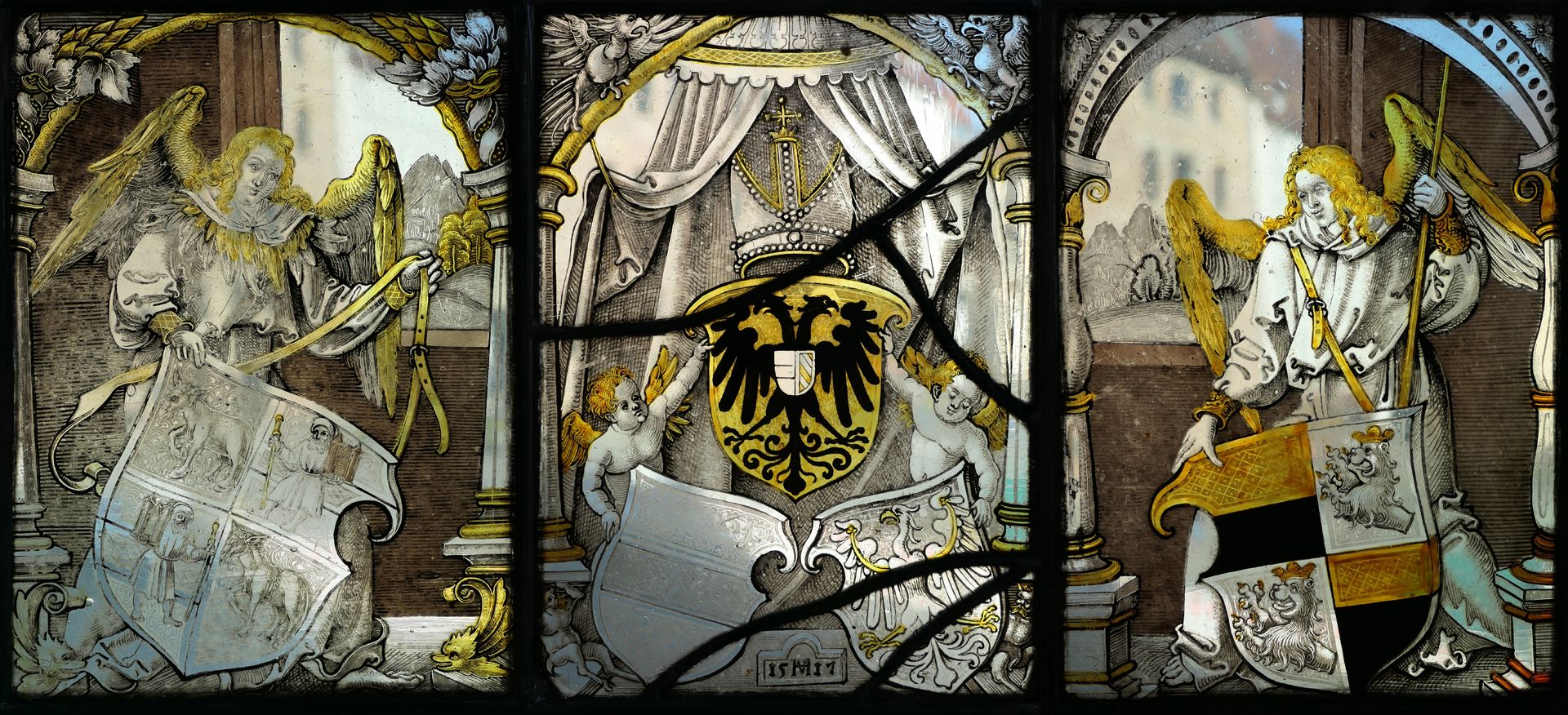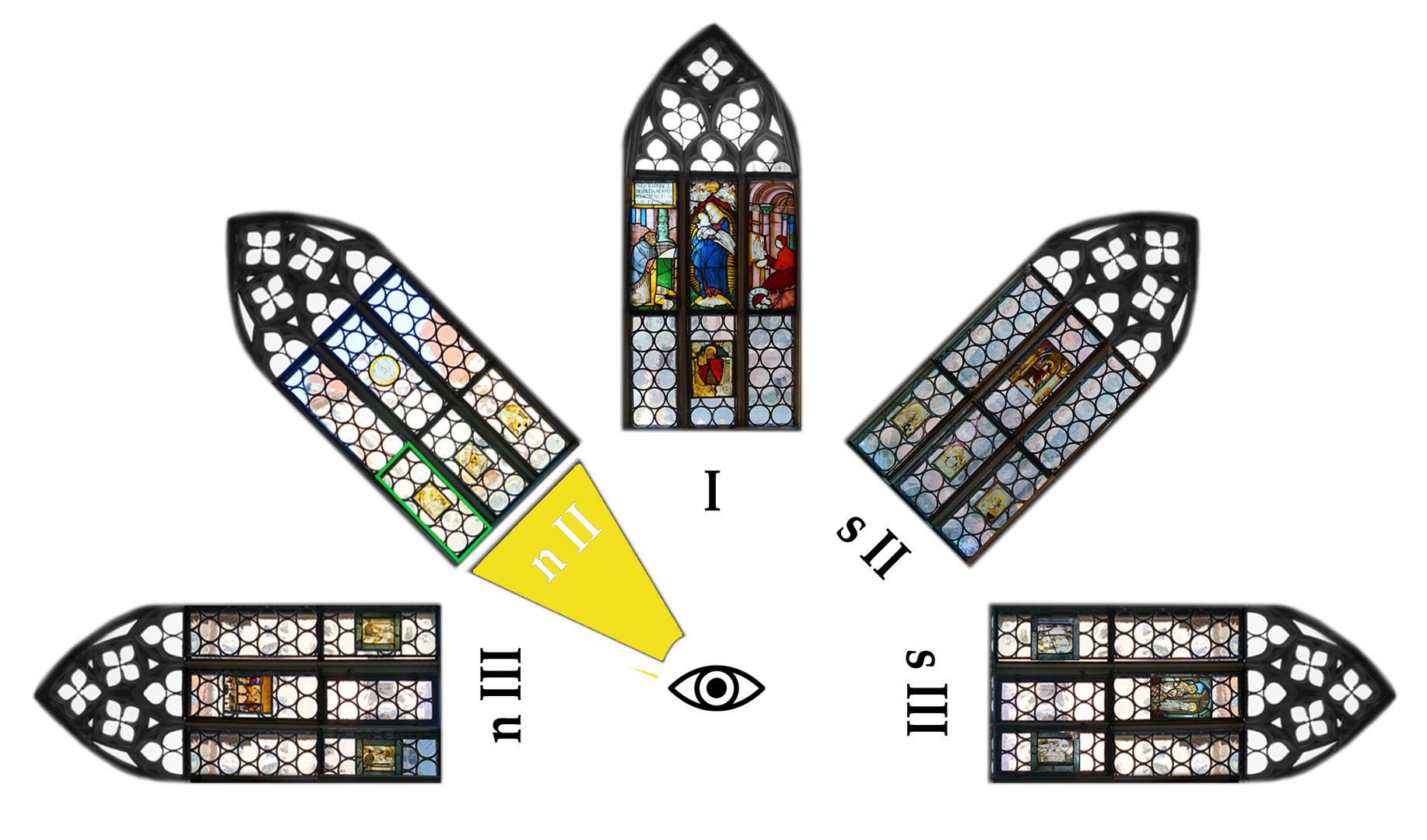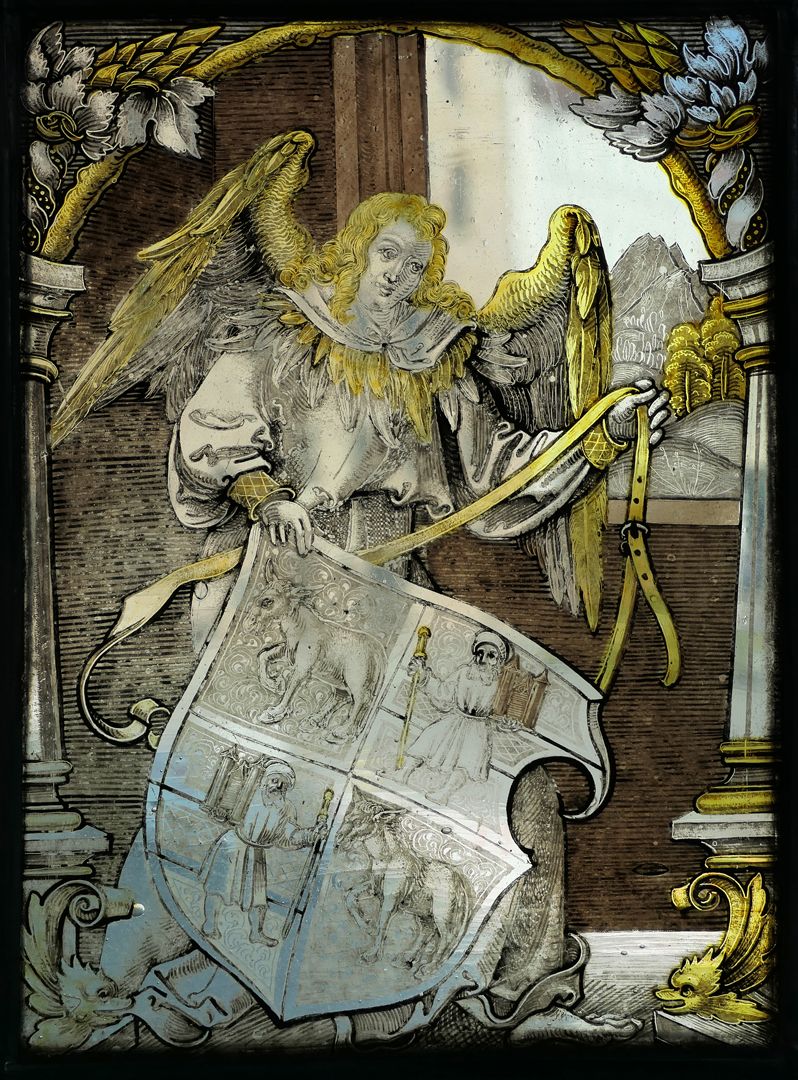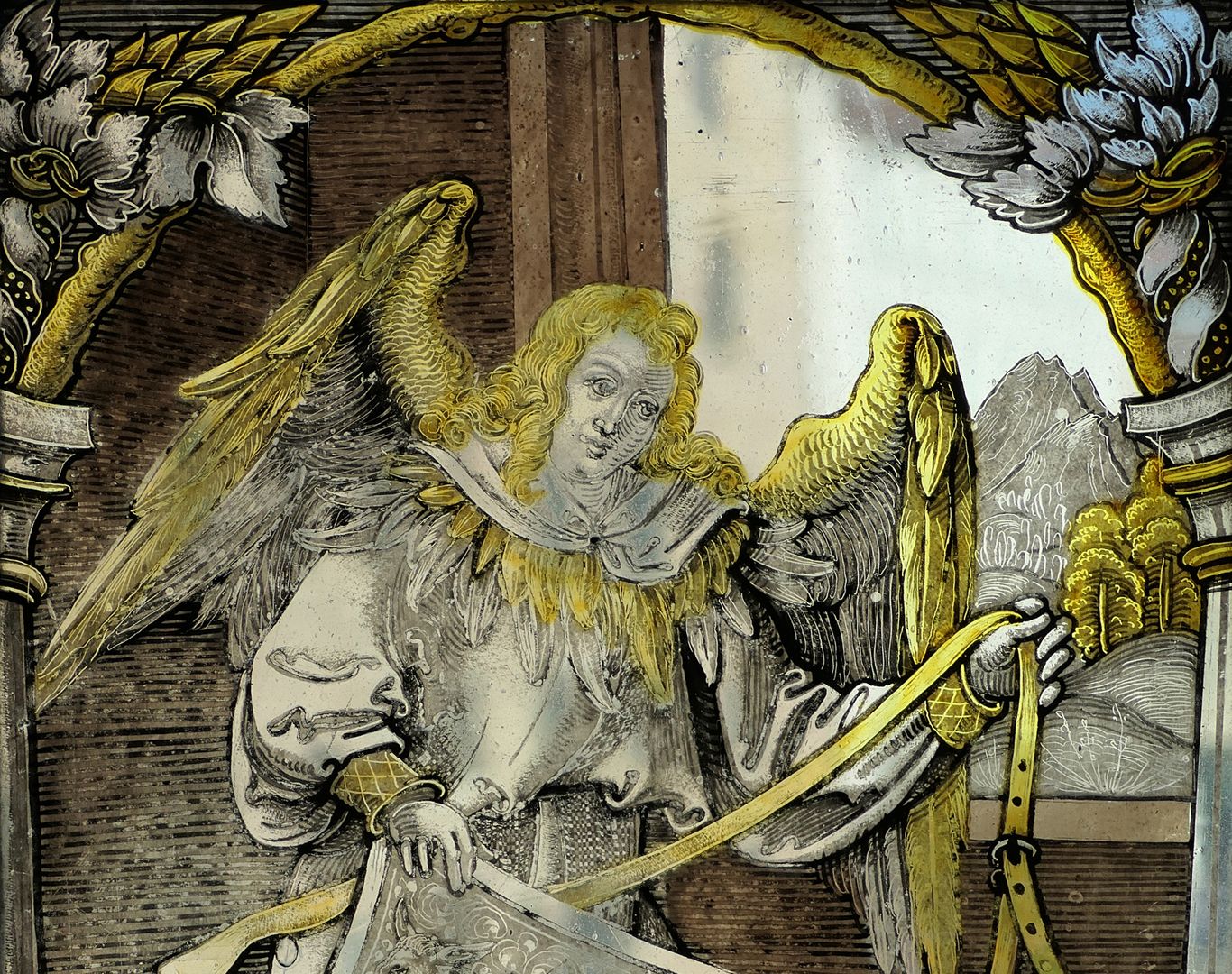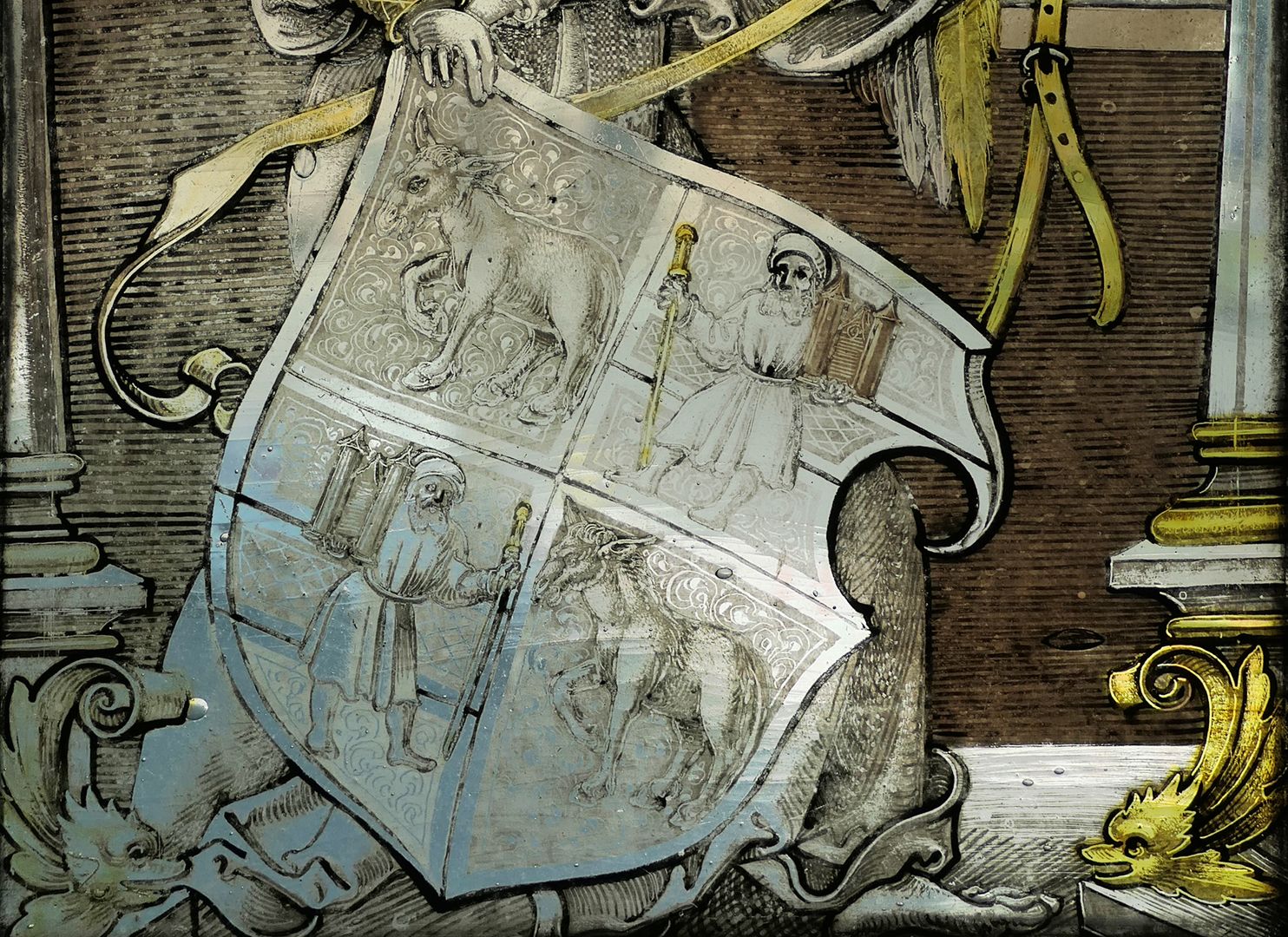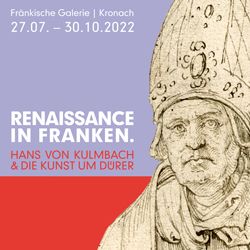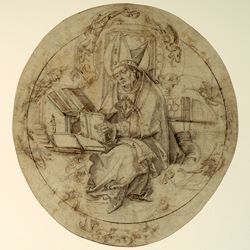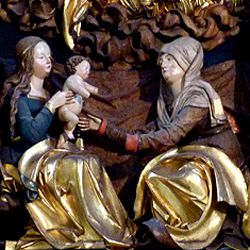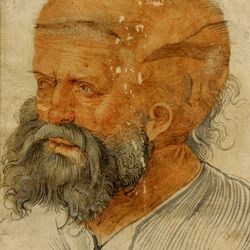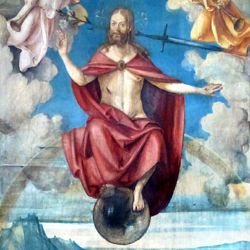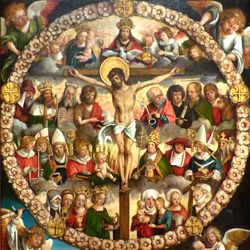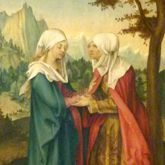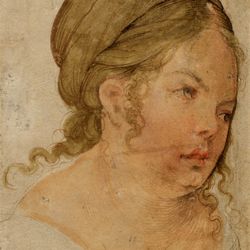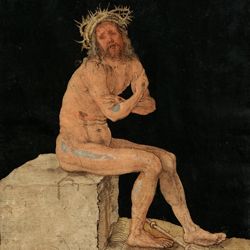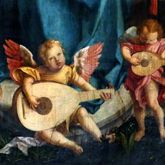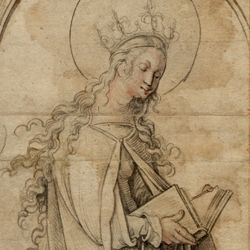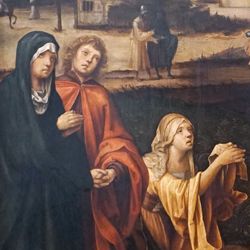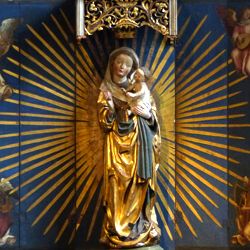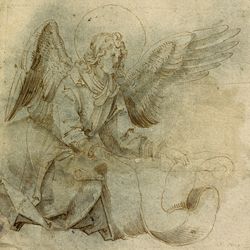Fenster nII 1 des Sebalder Chörleins
Fenster nII 1 des Sebalder Chörleins
1517
Site plan, second window in the row
Design: Hans von Kulmbach
Execution: Veit Hirsvogel (the younger /son of Veit Hirsvogel)
Also transferred to the east chancel of the vicarage after the war was a series with a total of three monolithic discs of angels holding coats of arms, dated 1517 and with the monogram VH - Veit Hirsvogel (meaning here the eldest son of the old Veit). This series of coats of arms was also based on design drawings by Hans von Kulmbach, one of which has been preserved in the collection of the École nationale supérieure des beaux-arts in Paris.
The signed and dated plate with the triple coat of arms under an open tent, crowned by the imperial crown, refers to Emperor Maximilian I. It shows, held by putti, the double-headed imperial eagle with the heart shield of Austria/Burgundy above, and the two full coats of arms of the Archduchy of Austria and the County of Tyrol below.
The four-part coat of arms Pfinzing/Grundherr, which is presented by an angel turned to the left, refers to the parents of the provost, Siegfrid Pfinzing von Henfenfeld (1514) and his wife Barbara née Grundherr, whose founder's image had already been depicted in a prominent position in the choir window s III in 1515.
The third coat of arms is also divided into four parts. (...) The depicted coat of arms alliance Eseler/Propstei St. Sebald is interpreted as an indication of a significant participation of the Eseler family, which died out in the 14th century, or of a member of the family in the new building and in the furnishing of the vicarage.
Hartmut Scholz: Masterpieces of Stained Glass, St. Sebald in Nuremberg, Freiburg i. Br., 2007
see also: Window sII 1 of the Sebalder Chörlein
Location: Nuremberg, Sebalder vicarage, Chörlein (oriel), window nII 1
Design: Kulmbach, Hans Süß von
Realization: Hirsvogel (Hirschvogel, Hirsfogel), Veit d. J.
Material: Glas
photo 2022, Theo Noll
Fenster nII 1 des Sebalder Chörleins
1517
Putti with coat of arms triple band: above the double-headed imperial eagle with heart shield Austria/Burgundy, below the two full coats of arms of the Archduchy of Austria and the County of Tyrol.
Design: Hans von Kulmbach
Execution: Veit Hirsvogel (the younger /son of Veit Hirsvogel)
Also transferred to the east chancel of the vicarage after the war was a series with a total of three monolithic discs of angels holding coats of arms, dated 1517 and with the monogram VH - Veit Hirsvogel (meaning here the eldest son of the old Veit). This series of coats of arms was also based on design drawings by Hans von Kulmbach, one of which has been preserved in the collection of the École nationale supérieure des beaux-arts in Paris.
The signed and dated plate with the triple coat of arms under an open tent, crowned by the imperial crown, refers to Emperor Maximilian I. It shows, held by putti, the double-headed imperial eagle with the heart shield of Austria/Burgundy above, and the two full coats of arms of the Archduchy of Austria and the County of Tyrol below.
The four-part coat of arms Pfinzing/Grundherr, which is presented by an angel turned to the left, refers to the parents of the provost, Siegfrid Pfinzing von Henfenfeld (1514) and his wife Barbara née Grundherr, whose founder's image had already been depicted in a prominent position in the choir window s III in 1515.
The third coat of arms is also divided into four parts. (...) The depicted coat of arms alliance Eseler/Propstei St. Sebald is interpreted as an indication of a significant participation of the Eseler family, which died out in the 14th century, or of a member of the family in the new building and in the furnishing of the vicarage.
Hartmut Scholz: Masterpieces of Stained Glass, St. Sebald in Nuremberg, Freiburg i. Br., 2007
see also: Window sII 1 of the Sebalder Chörlein
Location: Nuremberg, Sebalder vicarage, Chörlein (oriel), window nII 1
Design: Kulmbach, Hans Süß von
Realization: Hirsvogel (Hirschvogel, Hirsfogel), Veit d. J.
Material: Glas
photo 2022, Pablo de la Riestra
Fenster nII 1 des Sebalder Chörleins
1517
second window of the row, detail view with double headed imperial eagle
Design: Hans von Kulmbach
Execution: Veit Hirsvogel (the younger /son of Veit Hirsvogel)
Also transferred to the east chancel of the vicarage after the war was a series with a total of three monolithic discs of angels holding coats of arms, dated 1517 and with the monogram VH - Veit Hirsvogel (meaning here the eldest son of the old Veit). This series of coats of arms was also based on design drawings by Hans von Kulmbach, one of which has been preserved in the collection of the École nationale supérieure des beaux-arts in Paris.
The signed and dated plate with the triple coat of arms under an open tent, crowned by the imperial crown, refers to Emperor Maximilian I. It shows, held by putti, the double-headed imperial eagle with the heart shield of Austria/Burgundy above, and the two full coats of arms of the Archduchy of Austria and the County of Tyrol below.
The four-part coat of arms Pfinzing/Grundherr, which is presented by an angel turned to the left, refers to the parents of the provost, Siegfrid Pfinzing von Henfenfeld (1514) and his wife Barbara née Grundherr, whose founder's image had already been depicted in a prominent position in the choir window s III in 1515.
The third coat of arms is also divided into four parts. (...) The depicted coat of arms alliance Eseler/Propstei St. Sebald is interpreted as an indication of a significant participation of the Eseler family, which died out in the 14th century, or of a member of the family in the new building and in the furnishing of the vicarage.
Hartmut Scholz: Masterpieces of Stained Glass, St. Sebald in Nuremberg, Freiburg i. Br., 2007
see also: Window sII 1 of the Sebalder Chörlein
Location: Nuremberg, Sebalder vicarage, Chörlein (oriel), window nII 1b
Design: Kulmbach, Hans Süß von
Realization: Hirsvogel (Hirschvogel, Hirsfogel), Veit d. J.
Material: Glas
photo 2022, Pablo de la Riestra
Fenster nII 1 des Sebalder Chörleins
1517
second window of the row, detail view with coat of arms triple band, below artist signature VH 1517
Design: Hans von Kulmbach
Execution: Veit Hirsvogel (the younger /son of Veit Hirsvogel)
Also transferred to the east chancel of the vicarage after the war was a series with a total of three monolithic discs of angels holding coats of arms, dated 1517 and with the monogram VH - Veit Hirsvogel (meaning here the eldest son of the old Veit). This series of coats of arms was also based on design drawings by Hans von Kulmbach, one of which has been preserved in the collection of the École nationale supérieure des beaux-arts in Paris.
The signed and dated plate with the triple coat of arms under an open tent, crowned by the imperial crown, refers to Emperor Maximilian I. It shows, held by putti, the double-headed imperial eagle with the heart shield of Austria/Burgundy above, and the two full coats of arms of the Archduchy of Austria and the County of Tyrol below.
The four-part coat of arms Pfinzing/Grundherr, which is presented by an angel turned to the left, refers to the parents of the provost, Siegfrid Pfinzing von Henfenfeld (1514) and his wife Barbara née Grundherr, whose founder's image had already been depicted in a prominent position in the choir window s III in 1515.
The third coat of arms is also divided into four parts. (...) The depicted coat of arms alliance Eseler/Propstei St. Sebald is interpreted as an indication of a significant participation of the Eseler family, which died out in the 14th century, or of a member of the family in the new building and in the furnishing of the vicarage.
Hartmut Scholz: Masterpieces of Stained Glass, St. Sebald in Nuremberg, Freiburg i. Br., 2007
see also: Window sII 1 of the Sebalder Chörlein
Location: Nuremberg, Sebalder vicarage, Chörlein (oriel), window nII 1b
Design: Kulmbach, Hans Süß von
Realization: Hirsvogel (Hirschvogel, Hirsfogel), Veit d. J.
Material: Glas
photo 2022, Pablo de la Riestra
Fenster nII 1 des Sebalder Chörleins
1517
third window of the row
Design: Hans von Kulmbach
Execution: Veit Hirsvogel (the younger /son of Veit Hirsvogel)
Also transferred to the east chancel of the vicarage after the war was a series with a total of three monolithic discs of angels holding coats of arms, dated 1517 and with the monogram VH - Veit Hirsvogel (meaning here the eldest son of the old Veit). This series of coats of arms was also based on design drawings by Hans von Kulmbach, one of which has been preserved in the collection of the École nationale supérieure des beaux-arts in Paris.
The signed and dated plate with the triple coat of arms under an open tent, crowned by the imperial crown, refers to Emperor Maximilian I. It shows, held by putti, the double-headed imperial eagle with the heart shield of Austria/Burgundy above, and the two full coats of arms of the Archduchy of Austria and the County of Tyrol below.
The four-part coat of arms Pfinzing/Grundherr, which is presented by an angel turned to the left, refers to the parents of the provost, Siegfrid Pfinzing von Henfenfeld (1514) and his wife Barbara née Grundherr, whose founder's image had already been depicted in a prominent position in the choir window s III in 1515.
The third coat of arms is also divided into four parts. (...) The depicted coat of arms alliance Eseler/Propstei St. Sebald is interpreted as an indication of a significant participation of the Eseler family, which died out in the 14th century, or of a member of the family in the new building and in the furnishing of the vicarage.
Hartmut Scholz: Masterpieces of Stained Glass, St. Sebald in Nuremberg, Freiburg i. Br., 2007
see also: Window sII 1 of the Sebalder Chörlein
Location: Nuremberg, Sebalder vicarage, Chörlein (oriel), window nII 1c
Design: Kulmbach, Hans Süß von
Realization: Hirsvogel (Hirschvogel, Hirsfogel), Veit d. J.
Material: Glas
photo 2022, Theo Noll
Fenster nII 1 des Sebalder Chörleins
1517
Third window of the row, detailed view with fourparted coat of arms Pfinzing/Grundherr
Design: Hans von Kulmbach
Execution: Veit Hirsvogel (the younger /son of Veit Hirsvogel)
Also transferred to the east chancel of the vicarage after the war was a series with a total of three monolithic discs of angels holding coats of arms, dated 1517 and with the monogram VH - Veit Hirsvogel (meaning here the eldest son of the old Veit). This series of coats of arms was also based on design drawings by Hans von Kulmbach, one of which has been preserved in the collection of the École nationale supérieure des beaux-arts in Paris.
The signed and dated plate with the triple coat of arms under an open tent, crowned by the imperial crown, refers to Emperor Maximilian I. It shows, held by putti, the double-headed imperial eagle with the heart shield of Austria/Burgundy above, and the two full coats of arms of the Archduchy of Austria and the County of Tyrol below.
The four-part coat of arms Pfinzing/Grundherr, which is presented by an angel turned to the left, refers to the parents of the provost, Siegfrid Pfinzing von Henfenfeld (1514) and his wife Barbara née Grundherr, whose founder's image had already been depicted in a prominent position in the choir window s III in 1515.
The third coat of arms is also divided into four parts. (...) The depicted coat of arms alliance Eseler/Propstei St. Sebald is interpreted as an indication of a significant participation of the Eseler family, which died out in the 14th century, or of a member of the family in the new building and in the furnishing of the vicarage.
Hartmut Scholz: Masterpieces of Stained Glass, St. Sebald in Nuremberg, Freiburg i. Br., 2007
see also: Window sII 1 of the Sebalder Chörlein
Location: Nuremberg, Sebalder vicarage, Chörlein (oriel), window nII 1c
Design: Kulmbach, Hans Süß von
Realization: Hirsvogel (Hirschvogel, Hirsfogel), Veit d. J.
Material: Glas
photo 2022, Pablo de la Riestra
Fenster nII 1 des Sebalder Chörleins
1517
Third window of the row, detailed view with angel
Design: Hans von Kulmbach
Execution: Veit Hirsvogel (the younger /son of Veit Hirsvogel)
Also transferred to the east chancel of the vicarage after the war was a series with a total of three monolithic discs of angels holding coats of arms, dated 1517 and with the monogram VH - Veit Hirsvogel (meaning here the eldest son of the old Veit). This series of coats of arms was also based on design drawings by Hans von Kulmbach, one of which has been preserved in the collection of the École nationale supérieure des beaux-arts in Paris.
The signed and dated plate with the triple coat of arms under an open tent, crowned by the imperial crown, refers to Emperor Maximilian I. It shows, held by putti, the double-headed imperial eagle with the heart shield of Austria/Burgundy above, and the two full coats of arms of the Archduchy of Austria and the County of Tyrol below.
The four-part coat of arms Pfinzing/Grundherr, which is presented by an angel turned to the left, refers to the parents of the provost, Siegfrid Pfinzing von Henfenfeld (1514) and his wife Barbara née Grundherr, whose founder's image had already been depicted in a prominent position in the choir window s III in 1515.
The third coat of arms is also divided into four parts. (...) The depicted coat of arms alliance Eseler/Propstei St. Sebald is interpreted as an indication of a significant participation of the Eseler family, which died out in the 14th century, or of a member of the family in the new building and in the furnishing of the vicarage.
Hartmut Scholz: Masterpieces of Stained Glass, St. Sebald in Nuremberg, Freiburg i. Br., 2007
see also: Window sII 1 of the Sebalder Chörlein
Location: Nuremberg, Sebalder vicarage, Chörlein (oriel), window nII 1c
Design: Kulmbach, Hans Süß von
Realization: Hirsvogel (Hirschvogel, Hirsfogel), Veit d. J.
Material: Glas
photo 2022, Pablo de la Riestra
Fenster nII 1 des Sebalder Chörleins
1517
Third window of the row, detailed view with angel
Design: Hans von Kulmbach
Execution: Veit Hirsvogel (the younger /son of Veit Hirsvogel)
Also transferred to the east chancel of the vicarage after the war was a series with a total of three monolithic discs of angels holding coats of arms, dated 1517 and with the monogram VH - Veit Hirsvogel (meaning here the eldest son of the old Veit). This series of coats of arms was also based on design drawings by Hans von Kulmbach, one of which has been preserved in the collection of the École nationale supérieure des beaux-arts in Paris.
The signed and dated plate with the triple coat of arms under an open tent, crowned by the imperial crown, refers to Emperor Maximilian I. It shows, held by putti, the double-headed imperial eagle with the heart shield of Austria/Burgundy above, and the two full coats of arms of the Archduchy of Austria and the County of Tyrol below.
The four-part coat of arms Pfinzing/Grundherr, which is presented by an angel turned to the left, refers to the parents of the provost, Siegfrid Pfinzing von Henfenfeld (1514) and his wife Barbara née Grundherr, whose founder's image had already been depicted in a prominent position in the choir window s III in 1515.
The third coat of arms is also divided into four parts. (...) The depicted coat of arms alliance Eseler/Propstei St. Sebald is interpreted as an indication of a significant participation of the Eseler family, which died out in the 14th century, or of a member of the family in the new building and in the furnishing of the vicarage.
Hartmut Scholz: Masterpieces of Stained Glass, St. Sebald in Nuremberg, Freiburg i. Br., 2007
see also: Window sII 1 of the Sebalder Chörlein
Location: Nuremberg, Sebalder vicarage, Chörlein (oriel), window nII 1c
Design: Kulmbach, Hans Süß von
Realization: Hirsvogel (Hirschvogel, Hirsfogel), Veit d. J.
Material: Glas
photo 2022, Pablo de la Riestra
Fenster nII 1 des Sebalder Chörleins
1517
Third window of the row, detailed view with coat of arms Pfinzing/Grundherr
Design: Hans von Kulmbach
Execution: Veit Hirsvogel (the younger /son of Veit Hirsvogel)
Also transferred to the east chancel of the vicarage after the war was a series with a total of three monolithic discs of angels holding coats of arms, dated 1517 and with the monogram VH - Veit Hirsvogel (meaning here the eldest son of the old Veit). This series of coats of arms was also based on design drawings by Hans von Kulmbach, one of which has been preserved in the collection of the École nationale supérieure des beaux-arts in Paris.
The signed and dated plate with the triple coat of arms under an open tent, crowned by the imperial crown, refers to Emperor Maximilian I. It shows, held by putti, the double-headed imperial eagle with the heart shield of Austria/Burgundy above, and the two full coats of arms of the Archduchy of Austria and the County of Tyrol below.
The four-part coat of arms Pfinzing/Grundherr, which is presented by an angel turned to the left, refers to the parents of the provost, Siegfrid Pfinzing von Henfenfeld (1514) and his wife Barbara née Grundherr, whose founder's image had already been depicted in a prominent position in the choir window s III in 1515.
The third coat of arms is also divided into four parts. (...) The depicted coat of arms alliance Eseler/Propstei St. Sebald is interpreted as an indication of a significant participation of the Eseler family, which died out in the 14th century, or of a member of the family in the new building and in the furnishing of the vicarage.
Hartmut Scholz: Masterpieces of Stained Glass, St. Sebald in Nuremberg, Freiburg i. Br., 2007
see also: Window sII 1 of the Sebalder Chörlein
Location: Nuremberg, Sebalder vicarage, Chörlein (oriel), window nII 1c
Design: Kulmbach, Hans Süß von
Realization: Hirsvogel (Hirschvogel, Hirsfogel), Veit d. J.
Material: Glas
photo 2022, Pablo de la Riestra
Fenster nII 1 des Sebalder Chörleins
1517
Sebalder Chörlein, on the left the window nII
Design: Hans von Kulmbach
Execution: Veit Hirsvogel (the younger /son of Veit Hirsvogel)
Also transferred to the east chancel of the vicarage after the war was a series with a total of three monolithic discs of angels holding coats of arms, dated 1517 and with the monogram VH - Veit Hirsvogel (meaning here the eldest son of the old Veit). This series of coats of arms was also based on design drawings by Hans von Kulmbach, one of which has been preserved in the collection of the École nationale supérieure des beaux-arts in Paris.
The signed and dated plate with the triple coat of arms under an open tent, crowned by the imperial crown, refers to Emperor Maximilian I. It shows, held by putti, the double-headed imperial eagle with the heart shield of Austria/Burgundy above, and the two full coats of arms of the Archduchy of Austria and the County of Tyrol below.
The four-part coat of arms Pfinzing/Grundherr, which is presented by an angel turned to the left, refers to the parents of the provost, Siegfrid Pfinzing von Henfenfeld (1514) and his wife Barbara née Grundherr, whose founder's image had already been depicted in a prominent position in the choir window s III in 1515.
The third coat of arms is also divided into four parts. (...) The depicted coat of arms alliance Eseler/Propstei St. Sebald is interpreted as an indication of a significant participation of the Eseler family, which died out in the 14th century, or of a member of the family in the new building and in the furnishing of the vicarage.
Hartmut Scholz: Masterpieces of Stained Glass, St. Sebald in Nuremberg, Freiburg i. Br., 2007
see also: Window sII 1 of the Sebalder Chörlein
Location: Nuremberg, Sebalder vicarage, Chörlein (oriel), window nII
Design: Kulmbach, Hans Süß von
Realization: Hirsvogel (Hirschvogel, Hirsfogel), Veit d. J.
Material: Glas
photo 2023, Pablo de la Riestra
Fenster nII 1 des Sebalder Chörleins
1517
Site plan
Design: Hans von Kulmbach
Execution: Veit Hirsvogel (the younger /son of Veit Hirsvogel)
Also transferred to the east chancel of the vicarage after the war was a series with a total of three monolithic discs of angels holding coats of arms, dated 1517 and with the monogram VH - Veit Hirsvogel (meaning here the eldest son of the old Veit). This series of coats of arms was also based on design drawings by Hans von Kulmbach, one of which has been preserved in the collection of the École nationale supérieure des beaux-arts in Paris.
The signed and dated plate with the triple coat of arms under an open tent, crowned by the imperial crown, refers to Emperor Maximilian I. It shows, held by putti, the double-headed imperial eagle with the heart shield of Austria/Burgundy above, and the two full coats of arms of the Archduchy of Austria and the County of Tyrol below.
The four-part coat of arms Pfinzing/Grundherr, which is presented by an angel turned to the left, refers to the parents of the provost, Siegfrid Pfinzing von Henfenfeld (1514) and his wife Barbara née Grundherr, whose founder's image had already been depicted in a prominent position in the choir window s III in 1515.
The third coat of arms is also divided into four parts. (...) The depicted coat of arms alliance Eseler/Propstei St. Sebald is interpreted as an indication of a significant participation of the Eseler family, which died out in the 14th century, or of a member of the family in the new building and in the furnishing of the vicarage.
Hartmut Scholz: Masterpieces of Stained Glass, St. Sebald in Nuremberg, Freiburg i. Br., 2007
see also: Window sII 1 of the Sebalder Chörlein
Location: Nuremberg, Sebalder vicarage, Chörlein (oriel), window nII
Design: Kulmbach, Hans Süß von
Realization: Hirsvogel (Hirschvogel, Hirsfogel), Veit d. J.
Material: Glas
photo 2022, Theo Noll
Fenster nII 1 des Sebalder Chörleins
1517
Windows in a row
photo 2023, Pablo de la Riestra
Design: Hans von Kulmbach
Execution: Veit Hirsvogel (the younger /son of Veit Hirsvogel)
Also transferred to the east chancel of the vicarage after the war was a series with a total of three monolithic discs of angels holding coats of arms, dated 1517 and with the monogram VH - Veit Hirsvogel (meaning here the eldest son of the old Veit). This series of coats of arms was also based on design drawings by Hans von Kulmbach, one of which has been preserved in the collection of the École nationale supérieure des beaux-arts in Paris.
The signed and dated plate with the triple coat of arms under an open tent, crowned by the imperial crown, refers to Emperor Maximilian I. It shows, held by putti, the double-headed imperial eagle with the heart shield of Austria/Burgundy above, and the two full coats of arms of the Archduchy of Austria and the County of Tyrol below.
The four-part coat of arms Pfinzing/Grundherr, which is presented by an angel turned to the left, refers to the parents of the provost, Siegfrid Pfinzing von Henfenfeld (1514) and his wife Barbara née Grundherr, whose founder's image had already been depicted in a prominent position in the choir window s III in 1515.
The third coat of arms is also divided into four parts. (...) The depicted coat of arms alliance Eseler/Propstei St. Sebald is interpreted as an indication of a significant participation of the Eseler family, which died out in the 14th century, or of a member of the family in the new building and in the furnishing of the vicarage.
Hartmut Scholz: Masterpieces of Stained Glass, St. Sebald in Nuremberg, Freiburg i. Br., 2007
see also: Window sII 1 of the Sebalder Chörlein
Location: Nuremberg, Sebalder vicarage, Chörlein (oriel), window nII 1
Design: Kulmbach, Hans Süß von
Realization: Hirsvogel (Hirschvogel, Hirsfogel), Veit d. J.
Material: Glas
Fenster nII 1 des Sebalder Chörleins
1517
site plan, first window of the row
Design: Hans von Kulmbach
Execution: Veit Hirsvogel (the younger /son of Veit Hirsvogel)
Also transferred to the east chancel of the vicarage after the war was a series with a total of three monolithic discs of angels holding coats of arms, dated 1517 and with the monogram VH - Veit Hirsvogel (meaning here the eldest son of the old Veit). This series of coats of arms was also based on design drawings by Hans von Kulmbach, one of which has been preserved in the collection of the École nationale supérieure des beaux-arts in Paris.
The signed and dated plate with the triple coat of arms under an open tent, crowned by the imperial crown, refers to Emperor Maximilian I. It shows, held by putti, the double-headed imperial eagle with the heart shield of Austria/Burgundy above, and the two full coats of arms of the Archduchy of Austria and the County of Tyrol below.
The four-part coat of arms Pfinzing/Grundherr, which is presented by an angel turned to the left, refers to the parents of the provost, Siegfrid Pfinzing von Henfenfeld (1514) and his wife Barbara née Grundherr, whose founder's image had already been depicted in a prominent position in the choir window s III in 1515.
The third coat of arms is also divided into four parts. (...) The depicted coat of arms alliance Eseler/Propstei St. Sebald is interpreted as an indication of a significant participation of the Eseler family, which died out in the 14th century, or of a member of the family in the new building and in the furnishing of the vicarage.
Hartmut Scholz: Masterpieces of Stained Glass, St. Sebald in Nuremberg, Freiburg i. Br., 2007
see also: Window sII 1 of the Sebalder Chörlein
Location: Nürnberg, Sebalder Pfarrhof, Chörlein, Fenster nII 1a
Design: Kulmbach, Hans Süß von
Realization: Hirsvogel (Hirschvogel, Hirsfogel), Veit d. J.
Material: Glas
photo 2022, Theo Noll
Fenster nII 1 des Sebalder Chörleins
1517
angel with coat of arms, coat of arms alliance Eseler/Propstei St. Sebald
Design: Hans von Kulmbach
Execution: Veit Hirsvogel (the younger /son of Veit Hirsvogel)
Also transferred to the east chancel of the vicarage after the war was a series with a total of three monolithic discs of angels holding coats of arms, dated 1517 and with the monogram VH - Veit Hirsvogel (meaning here the eldest son of the old Veit). This series of coats of arms was also based on design drawings by Hans von Kulmbach, one of which has been preserved in the collection of the École nationale supérieure des beaux-arts in Paris.
The signed and dated plate with the triple coat of arms under an open tent, crowned by the imperial crown, refers to Emperor Maximilian I. It shows, held by putti, the double-headed imperial eagle with the heart shield of Austria/Burgundy above, and the two full coats of arms of the Archduchy of Austria and the County of Tyrol below.
The four-part coat of arms Pfinzing/Grundherr, which is presented by an angel turned to the left, refers to the parents of the provost, Siegfrid Pfinzing von Henfenfeld (1514) and his wife Barbara née Grundherr, whose founder's image had already been depicted in a prominent position in the choir window s III in 1515.
The third coat of arms is also divided into four parts. (...) The depicted coat of arms alliance Eseler/Propstei St. Sebald is interpreted as an indication of a significant participation of the Eseler family, which died out in the 14th century, or of a member of the family in the new building and in the furnishing of the vicarage.
Hartmut Scholz: Masterpieces of Stained Glass, St. Sebald in Nuremberg, Freiburg i. Br., 2007
see also: Window sII 1 of the Sebalder Chörlein
Location: Nuremberg, Sebalder vicarage, Chörlein (oriel), window nII 1a
Design: Kulmbach, Hans Süß von
Realization: Hirsvogel (Hirschvogel, Hirsfogel), Veit d. J.
Material: Glas
photo 2022, Pablo de la Riestra
Fenster nII 1 des Sebalder Chörleins
1517
angel with coat of arms, coat of arms alliance Eseler/Propstei St. Sebald, detail view with angel
Design: Hans von Kulmbach
Execution: Veit Hirsvogel (the younger /son of Veit Hirsvogel)
Also transferred to the east chancel of the vicarage after the war was a series with a total of three monolithic discs of angels holding coats of arms, dated 1517 and with the monogram VH - Veit Hirsvogel (meaning here the eldest son of the old Veit). This series of coats of arms was also based on design drawings by Hans von Kulmbach, one of which has been preserved in the collection of the École nationale supérieure des beaux-arts in Paris.
The signed and dated plate with the triple coat of arms under an open tent, crowned by the imperial crown, refers to Emperor Maximilian I. It shows, held by putti, the double-headed imperial eagle with the heart shield of Austria/Burgundy above, and the two full coats of arms of the Archduchy of Austria and the County of Tyrol below.
The four-part coat of arms Pfinzing/Grundherr, which is presented by an angel turned to the left, refers to the parents of the provost, Siegfrid Pfinzing von Henfenfeld (1514) and his wife Barbara née Grundherr, whose founder's image had already been depicted in a prominent position in the choir window s III in 1515.
The third coat of arms is also divided into four parts. (...) The depicted coat of arms alliance Eseler/Propstei St. Sebald is interpreted as an indication of a significant participation of the Eseler family, which died out in the 14th century, or of a member of the family in the new building and in the furnishing of the vicarage.
Hartmut Scholz: Masterpieces of Stained Glass, St. Sebald in Nuremberg, Freiburg i. Br., 2007
see also: Window sII 1 of the Sebalder Chörlein
Location: Nuremberg, Sebalder vicarage, Chörlein (oriel), window nII 1a
Design: Kulmbach, Hans Süß von
Realization: Hirsvogel (Hirschvogel, Hirsfogel), Veit d. J.
Material: Glas
photo 2022, Pablo de la Riestra
Fenster nII 1 des Sebalder Chörleins
1517
angel with coat of arms, coat of arms alliance Eseler/Propstei St. Sebald, detail view with coat of arms
Design: Hans von Kulmbach
Execution: Veit Hirsvogel (the younger /son of Veit Hirsvogel)
Also transferred to the east chancel of the vicarage after the war was a series with a total of three monolithic discs of angels holding coats of arms, dated 1517 and with the monogram VH - Veit Hirsvogel (meaning here the eldest son of the old Veit). This series of coats of arms was also based on design drawings by Hans von Kulmbach, one of which has been preserved in the collection of the École nationale supérieure des beaux-arts in Paris.
The signed and dated plate with the triple coat of arms under an open tent, crowned by the imperial crown, refers to Emperor Maximilian I. It shows, held by putti, the double-headed imperial eagle with the heart shield of Austria/Burgundy above, and the two full coats of arms of the Archduchy of Austria and the County of Tyrol below.
The four-part coat of arms Pfinzing/Grundherr, which is presented by an angel turned to the left, refers to the parents of the provost, Siegfrid Pfinzing von Henfenfeld (1514) and his wife Barbara née Grundherr, whose founder's image had already been depicted in a prominent position in the choir window s III in 1515.
The third coat of arms is also divided into four parts. (...) The depicted coat of arms alliance Eseler/Propstei St. Sebald is interpreted as an indication of a significant participation of the Eseler family, which died out in the 14th century, or of a member of the family in the new building and in the furnishing of the vicarage.
Hartmut Scholz: Masterpieces of Stained Glass, St. Sebald in Nuremberg, Freiburg i. Br., 2007
see also: Window sII 1 of the Sebalder Chörlein
Location: Nuremberg, Sebalder vicarage, Chörlein (oriel), window nII 1a
Design: Kulmbach, Hans Süß von
Realization: Hirsvogel (Hirschvogel, Hirsfogel), Veit d. J.
Material: Glas
photo 2022, Pablo de la Riestra
